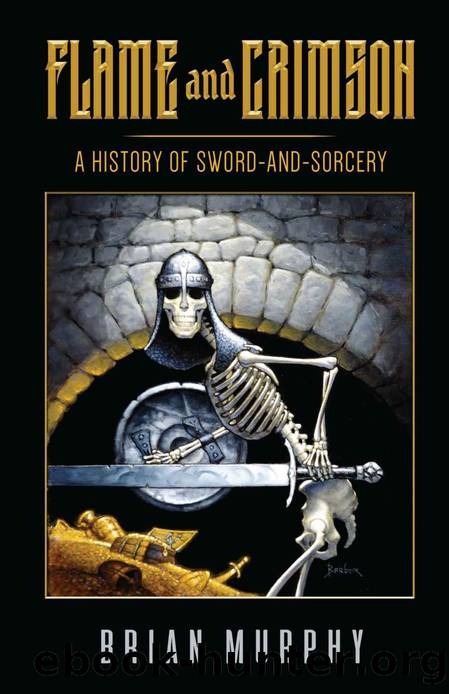Flame and Crimson: A History of Sword-and-Sorcery by Brian Murphy

Author:Brian Murphy [Murphy, Brian]
Language: eng
Format: epub
Tags: conan, lovecraft, heroic fantasy, weird tales, grimdark
Publisher: Pulp Hero Press
Published: 2020-02-22T04:00:00+00:00
Jack Vance (1916â2013)
More than a decade before the sword-and-sorcery renaissance, a curious volume called The Dying Earth (1950) appeared with little fanfare from Hillman Periodicals, known largely as a publisher of true crime, romance, war, and westerns. The relative indifference with which it was first received may have been due to genre confusion: not quite fantasy enough for Howard-heads, nor proper âhardâ science fiction favored by readers of Analog, The Dying Earth did not fit neatly into any one genre. Its cover was suitably mysterious and opaque, featuring a well-proportioned female in a gauzy gown, foregrounded by a trio of vaguely menacing, conspiratorial, cowled men, against a backdrop of stars. Then and today The Dying Earth is often categorized as science fiction, and not inaccurately. The action takes place on a literal âdying Earthâ of a distant future. Our planet is in its final throes, its aging, decaying sun on the verge of burning out and plunging the world into darkness. Flying cars and anti-gravity elevators dot the landscape, but have fallen into disuse and decay. Cities are abandoned, mute testaments of mankindâs past achievements before the apocalypse. Today, some credit its author, Jack Vance, for creating an entirely new âdying earthâ subgenre (âDying Earth,â The Encyclopedia of Science Fiction).
But a closer look at The Dying Earth reveals a much closer affinity with fantasy, and in particular sword-and-sorcery. Duels are fought with swords instead of guns. Horses and sail have resumed ascendancy over manned flight and the automobile. Most critically, magic has replaced science. Though the backdrop is vast and an irrecoverable apocalypse looms, the aims of its cast of characters are refreshingly small, often involving petty quests for personal enrichment. And the storiesâsix in the first volumeâare short, loosely connected only by the grim universe in which they are set.3 Later post-Hillman editions made The Dying Earthâs sword-and-sorcery heritage far more explicit. A 1977 Pocket Books edition for example featured a sword-wielding, heroically proportioned warrior with tunic and cape battling an ogre with a helpless female draped over one monstrous arm, with a dark castle looming in the background. Yet its cover blurb maintained a degree of ambivalence, declaring it âThe classic science fantasy of the world on the eve of destruction.â
More than 60 years after its publication, The Dying Earth retains a classic status in the genre due to its well-crafted prose. Vanceâs style is of the James Branch Cabell/Lord Dunsany/Clark Ashton Smith schoolâevocative and atmospheric, studded with strange names and references left enchantingly unexplainedâthough also highly readable, lucid, and modern. In Flashing Swords #1, Carter declared Vance âvirtually the only genuine stylist the field has recently producedâ (Flashing Swords #1 41). Here is a sample of his prose, from âTurjan of Miirâ:
Turjan hesitated, then opened his eyes. It was night in white-walled Kaiin, and festival time. Orange lanterns floated in the air, moving as the breeze took them. From the balconies dangled flower chains and cages of blue fire-flies. The streets surged with the wine-flushed populace, costumed in a multitude of bizarre modes.
Download
This site does not store any files on its server. We only index and link to content provided by other sites. Please contact the content providers to delete copyright contents if any and email us, we'll remove relevant links or contents immediately.
The Power of Myth by Joseph Campbell & Bill Moyers(1011)
Half Moon Bay by Jonathan Kellerman & Jesse Kellerman(953)
A Social History of the Media by Peter Burke & Peter Burke(936)
Inseparable by Emma Donoghue(931)
The Nets of Modernism: Henry James, Virginia Woolf, James Joyce, and Sigmund Freud by Maud Ellmann(834)
The Spike by Mark Humphries;(765)
The Complete Correspondence 1928-1940 by Theodor W. Adorno & Walter Benjamin(746)
A Theory of Narrative Drawing by Simon Grennan(742)
Culture by Terry Eagleton(721)
Ideology by Eagleton Terry;(696)
Bodies from the Library 3 by Tony Medawar(682)
World Philology by(675)
Farnsworth's Classical English Rhetoric by Ward Farnsworth(673)
Game of Thrones and Philosophy by William Irwin(670)
High Albania by M. Edith Durham(658)
Adam Smith by Jonathan Conlin(648)
A Reader’s Companion to J. D. Salinger’s The Catcher in the Rye by Peter Beidler(646)
Comic Genius: Portraits of Funny People by(616)
Monkey King by Wu Cheng'en(609)
